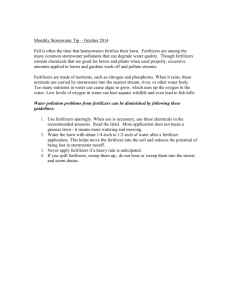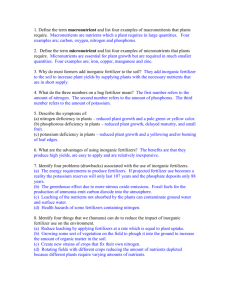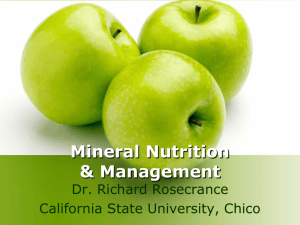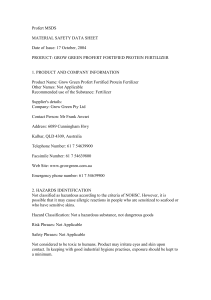Rating Methodology for Fertilizer Companies Industry Overview
advertisement
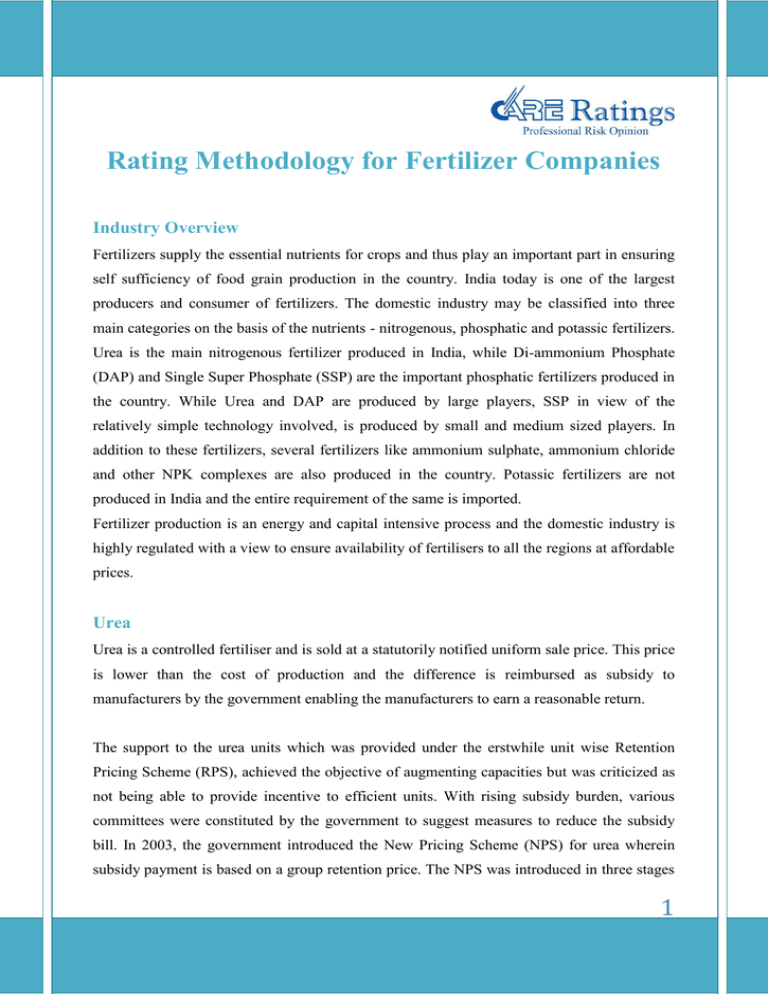
Rating Methodology for Fertilizer Companies Industry Overview Fertilizers supply the essential nutrients for crops and thus play an important part in ensuring self sufficiency of food grain production in the country. India today is one of the largest producers and consumer of fertilizers. The domestic industry may be classified into three main categories on the basis of the nutrients - nitrogenous, phosphatic and potassic fertilizers. Urea is the main nitrogenous fertilizer produced in India, while Di-ammonium Phosphate (DAP) and Single Super Phosphate (SSP) are the important phosphatic fertilizers produced in the country. While Urea and DAP are produced by large players, SSP in view of the relatively simple technology involved, is produced by small and medium sized players. In addition to these fertilizers, several fertilizers like ammonium sulphate, ammonium chloride and other NPK complexes are also produced in the country. Potassic fertilizers are not produced in India and the entire requirement of the same is imported. Fertilizer production is an energy and capital intensive process and the domestic industry is highly regulated with a view to ensure availability of fertilisers to all the regions at affordable prices. Urea Urea is a controlled fertiliser and is sold at a statutorily notified uniform sale price. This price is lower than the cost of production and the difference is reimbursed as subsidy to manufacturers by the government enabling the manufacturers to earn a reasonable return. The support to the urea units which was provided under the erstwhile unit wise Retention Pricing Scheme (RPS), achieved the objective of augmenting capacities but was criticized as not being able to provide incentive to efficient units. With rising subsidy burden, various committees were constituted by the government to suggest measures to reduce the subsidy bill. In 2003, the government introduced the New Pricing Scheme (NPS) for urea wherein subsidy payment is based on a group retention price. The NPS was introduced in three stages 1 and the Stage III of the policy is on with effect from October 2006. While the focus of the earlier ‘cost plus’ schemes was on capacity creation and ensuring assured returns to the sector, the focus of the NPS has been to encourage efficiencies in the sector. Phosphates The Government decontrolled phosphates in 1992 but comparatively higher returns ‘guaranteed’ under RPS led to disproportionate rise in urea production and consumption which resulted in skewing of the NPK ratio. Hence from 1993 onwards, the government started paying an ‘ad-hoc’ concession to the manufacturers of phosphatic fertilizers under the concession scheme. The subsidy mechanism has evolved over the years and from April 1, 2010 the Government has introduced the Nutrient Based Subsidy (NBS) scheme, wherein the Government has fixed the subsidy payable on various phosphatic and potassic fertilizers upfront at the beginning of the year (based on the nutrient content in each of these fertilizers) as opposed to the earlier system of ad-hoc concession on a quarterly/monthly basis. Under the NBS, players in the industry are free to fix the prices of their products as opposed to the earlier system of an indicative MRP. Demand-supply dynamics of Fertilizer industry Demand for fertilizers stems directly from agriculture. The type of crops grown, the extent of irrigation, use of high-yielding variety of seeds etc determine the requirements of fertilizers. The country has seen a sharp rise in fertilizer consumption since independence. While the years post independence saw capacity creation by public sector companies, the stable policy environment and the assured returns under the RPS also ensured sufficient capacity of Urea in the eighties. Of late however, there have not been any significant capacity additions and the country is forced to depend on imports to meet the growing demand. In terms of phosphatic fertilizers, while capacities have been added since independence, domestic capacity utilization has been dependent on the policy environment for the sector. Historically, the extent of reliance on imports for phosphatic fertilizers has been higher than that of nitrogenous fertilizers. 2 Rating Methodology CARE has a well laid out methodology for rating of companies belonging to the manufacturing sector. As per this methodology, CARE’s rating process begins with the evaluation of the economy/industry in which the company operates, followed by the assessment of the business risk factors specific to the company. This is followed by an assessment of the financial and project-related risk factors as well as the quality of the management. This methodology is followed while analyzing all the industries that come under the purview of the manufacturing sector. However, considering the size and diversity of the sector, CARE has developed methodologies specific to various industries within the sector. These methodologies attempt to point out factors, over and above those mentioned in the broad methodology, which will be assessed while carrying out rating exercises of companies belonging to the particular industry. The following is a list of such additional factors, along with their analytical implications, considered by CARE while arriving at the rating of the players that operate in the Fertilizer Industry. Regulatory framework The fertilizer industry being a highly regulated industry, Government polices for the industry and their impact on the specific company is a key input in CARE’s framework for rating of fertilizer companies. Any changes or modification to the policy framework within which the industry operates has a bearing on the overall business profile and profitability of a fertilizer company. Subsidy schemes and mechanism for the delivery of subsidies are key aspects of the regulatory framework which also have a bearing on the working capital requirements of the companies. Given the strategic importance of the industry, CARE believes that Government control is bound to exist in some form or the other and will continue to play an important role in determining the fortunes of the industry. Cost Competitiveness Energy efficiency Energy efficiency of fertilizer production is indicated by kilo calories of feedstock used to manufacture one unit of final product. Energy efficiency in turn depends on the type of feedstock used and the vintage of the plants. Under the existing system of subsidy 3 computation for urea units, the units are classified into six categories on the basis of the feedstock and vintage and subsidy is computed. Within each group, the more efficient plants stand to benefit. NPS also prescribes strict energy consumption norms for the units. In respect of phosphates too cost-efficient manufacturers are also bound to gain as the subsidy payable on the products is fixed. Feedstock Urea can be produced using Natural gas, naphtha, fuel oil or coal as feedstock. Naphtha and natural gas have been the main feedstock used for manufacture of urea though a few plants based on fuel oil/LSHS and coal do exist in the country. Government policies in the recent past have encouraged the use of gas as feedstock for the manufacture of urea. Use of lessefficient feedstock would not only mean uneconomical cost of production, but also invite penalties in the subsidy payouts in future. Fertilizer units in the country today are faced with gas shortages and under such circumstances, CARE reviews the ability of the company to have long-term tie-ups for its gas requirements at competitive rates. In the case of the phosphatic fertilizers, the main raw material used is phosphoric acid. The country depends to a large extent on imports for phosphoric acid. Backward integration into production of phosphoric acid and firming up sourcing arrangements (in case of imports) for phosphoric acid would be important considerations. CARE believes that the type of feedstock/raw material used and sourcing arrangement for the same and ability to control energy costs especially in a fixed-subsidy regime would be key to the competitiveness and long-term fundamentals of a fertilizer company. Product Profile Fertilizer companies in India range from single-product, single-location companies to large multi-product fertilizer complexes and with plants located in multiple locations. It is a prevalent characteristic in this industry that though companies may have manufacturing capabilities to manufacture one or a few products, they have a wide ‘bouquet’ of products to cater to the entire requirement of the farmer. For example, companies may manufacture urea in their own units but may additionally market or trade other fertilizers or even pesticides. This is mainly to cash in on the brand image the company’s fertilizer products may have earned over a period. The NBS also encourages the use of other secondary nutrients and 4 micro nutrients thus providing scope for introduction of newer products catering to localized requirements. CARE takes into account a company’s product profile and size as compared to other companies in the industry. Modernization plans India has a number of urea manufacturing units which are relatively old and are based on inefficient feedstock like naphtha, coal, fuel oil etc. With increased focus on efficiency, these plants will have to undergo modernization in terms of de-bottlenecking, revamp etc. Additionally, with the government favoring conversion to gas, plants based on other feedstock will have to convert to gas sooner or later. CARE reviews the proposed modernization plans, funding of these plans and the benefits that are likely to accrue. Market position In the totally deregulated scenario as is the case with phosphates and potassic fertilizers today, price-based competition cannot be ruled out. Under such circumstances, the company’s distribution network and its ability to rein in freight and logistics cost would be of key importance. Fertilizer companies with large and well-established distribution network would also be less susceptible to the regional demand-supply fluctuations. Additionally, though the fertilizer business may be a commodity business, product differentiation, branding and provision of farm support services are expected to gain greater importance. CARE positively views those companies which have a nationwide distribution network and are located closer to user markets, as these companies would stand to have a distinct competitive advantage. Conclusion The rating outcome is ultimately an assessment of the fundamentals and the probabilities of change in the fundamentals. CARE analyses each of the above factors and their linkages to arrive at the overall assessment of credit quality, by taking into account industry’s cyclicality. While the methodology encompasses comprehensive technical, financial, commercial, economic and management analysis, credit rating is an overall assessment of all aspects of the issuer. 5 HEAD OFFICE - MUMBAI CREDIT ANALYSIS & RESEARCH LTD 4th Floor, Godrej Coliseum, Somaiya Hospital Road, Off Eastern Express Highway, Sion (East), Mumbai - 400 022. Tel: +91-022- 6754 3456 email:care@careratings.com Website:www.careratings.com Regional Offices Branch Offices Unit No. O-509/C, Spencer Plaza, 5th Floor, No. 769, Anna Salai, Chennai 600 002 Tel: (044) 2849 7812/2849 0811 401, Ashoka Scintilla 3-6-520, Himayat Nagar Hyderabad - 500 029 Tel.: (040) – 40102030/31, 91600 04563 3rd floor, B-47, Inner Circle, Near Plaza Cinema, Connaught Place, New Delhi - 110 001. Tel: +91- 011- 2331 8701/ 2371 6199 Cell: 98117 45677 Unit No. 8, I floor, Commander's Place No. 6, Raja Ram Mohan Roy Road, Richmond Circle, Bangalore - 560 025. Tel.: (080) - 2211 7140/41, 9886024430 3rd Floor, Prasad Chambers (Shagun Mall Building), 10A, Shakespeare Sarani, Kolkata - 700 071 Tel: (033)- 2283 1800/ 1803/ 2280 8472 32 TITANIUM Prahaladnagar Corporate Road, Satellite, Ahmedabad - 380 015. Tel.: (079) 4026 5656 6 Disclaimer CARE’s ratings are opinions on credit quality and are not recommendations to sanction, renew, disburse or recall the concerned bank facilities or to buy, sell or hold any security. CARE has based its ratings on information obtained from sources believed by it to be accurate and reliable. CARE does not, however, guarantee the accuracy, adequacy or completeness of any information and is not responsible for any errors or omissions or for the results obtained from the use of such information. Most entities whose bank facilities/instruments are rated by CARE have paid a credit rating fee, based on the amount and type of bank facilities/instruments. 7

